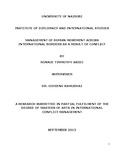| dc.description.abstract | This study will investigate the impact of conflict and worse still when the conflict becomes violent leading to movement of human population, it will explore to find out what are the consequences of human movement in times of conflict and worse still when this movement is across international borders. Issues such as border control measures and the right to seek asylum create a tricky balance for the host state. The study will look at and analyze what are some of the consequences of movement of a large human population across international borders and the impact not only to the migrating population but also to the host Government and the host human population. The objective of the study is to clearly create a balance between national security of a host country and the international doctrine where everyone has a right to seek asylum so as to protect their life and safety. It will finally zero in and look at recommendations on how to manage this influx human movement. The study will also look at case studies who have experienced influx migration of foreign population as a result of conflict, Kenya herein being a classic example as it is home to more than 400 000 Somali Refugees who experience xenophobic attitudes from Kenyan nationals, because of different factors including; their perceived economic strength as opposed to Kenyan nationals, their increase in competition for resources, and the current insecurity incidents giving the perception that they are a threat to National security. The study therefore presumes that countries are not well prepared and equipped to manage influx entry of a foreign population. The study hypothesizes that conflict is here to stay and their needs to be effective ways to manage human movement brought about by conflict especially during influx human movement. In pursuit of this objectives and hypothesis, the study adopted a methodology with three components of tool analysis. The first is primary and secondary data analysis. This involves a critical analysis of both published and unpublished material that deal with human movement and conflict. The second component is face to face interviews with stake holders in Kenya who face the problem of mass migration and information from interviews from the print media and the third was through interaction with group participants on the basis of their knowledge and experience with regards to influx entry of foreign population. The study employed the qualitative aspect of the research procedures and narratives in explaining its findings. The research found that the problem of human movement across international borders as a result of conflict is real and needs to be addressed as a matter of priority. In concluding, the research supposes that their needs to be comprehensive reforms in asylum laws, Host community perception and the international community as a whole when dealing with forced human migration as a result of conflict. | en |

